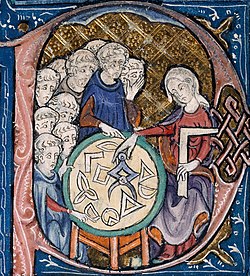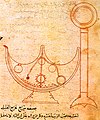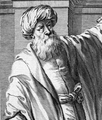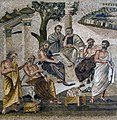Portal:History of science
The History of Science Portal
The history of science covers the development of science from ancient times to the present. It encompasses all three major branches of science: natural, social, and formal. Protoscience, early sciences, and natural philosophies such as alchemy and astrology during the Bronze Age, Iron Age, classical antiquity, and the Middle Ages declined during the early modern period after the establishment of formal disciplines of science in the Age of Enlightenment.
Science's earliest roots can be traced to Ancient Egypt and Mesopotamia around 3000 to 1200 BCE. These civilizations' contributions to mathematics, astronomy, and medicine influenced later Greek natural philosophy of classical antiquity, wherein formal attempts were made to provide explanations of events in the physical world based on natural causes. After the fall of the Western Roman Empire, knowledge of Greek conceptions of the world deteriorated in Latin-speaking Western Europe during the early centuries (400 to 1000 CE) of the Middle Ages, but continued to thrive in the Greek-speaking Byzantine Empire. Aided by translations of Greek texts, the Hellenistic worldview was preserved and absorbed into the Arabic-speaking Muslim world during the Islamic Golden Age. The recovery and assimilation of Greek works and Islamic inquiries into Western Europe from the 10th to 13th century revived the learning of natural philosophy in the West. Traditions of early science were also developed in ancient India and separately in ancient China, the Chinese model having influenced Vietnam, Korea and Japan before Western exploration. Among the Pre-Columbian peoples of Mesoamerica, the Zapotec civilization established their first known traditions of astronomy and mathematics for producing calendars, followed by other civilizations such as the Maya.
Natural philosophy was transformed during the Scientific Revolution in 16th- to 17th-century Europe, as new ideas and discoveries departed from previous Greek conceptions and traditions. The New Science that emerged was more mechanistic in its worldview, more integrated with mathematics, and more reliable and open as its knowledge was based on a newly defined scientific method. More "revolutions" in subsequent centuries soon followed. The chemical revolution of the 18th century, for instance, introduced new quantitative methods and measurements for chemistry. In the 19th century, new perspectives regarding the conservation of energy, age of Earth, and evolution came into focus. And in the 20th century, new discoveries in genetics and physics laid the foundations for new sub disciplines such as molecular biology and particle physics. Moreover, industrial and military concerns as well as the increasing complexity of new research endeavors ushered in the era of "big science," particularly after World War II. (Full article...)
Selected article -

Physics is a branch of science in which the primary objects of study are matter and energy. These topics were discussed by philosophers across many cultures in ancient times, but they had no means to distinguish causes of natural phenomena from superstitions. The scientific revolution of the 17th century, especially the discovery of the law of gravity, began a process knowledge accumulation and specialization that gave rise to the field of physics. Mathematical advances of the 18th century gave rise to classical mechanics and the increased used of the experimental method lead new understanding of thermodynamics. In the 19th century, the basic laws of electromagnetism and statistical mechanics were discovered. Physics was transformed by the discoveries of quantum mechanics, relativity, and atomic theory at the beginning of the 20th century. Physics today may be divided loosely into classical physics and modern physics.
Detailed articles on specific topics are available through the Outline of the history of physics. (Full article...)
Selected image

In this detail from an early 14th century copy of Euclid's Elements, a woman is shown teaching geometry. It is a detail of a scene in the bowl of the letter 'P'; the woman, with a set-square and dividers, uses a compass to measure distances on a diagram. In her left hand she holds a square, an implement for testing or drawing right angles. She is watched by a group of students. In images from the Middle Ages, it is unusual to see women represented as teachers, in particular when the students appear to be monks. She may be the personification of Geometry.
Did you know
...that the history of biochemistry spans approximately 400 years, but the word "biochemistry" in the modern sense was first proposed only in 1903, by German chemist Carl Neuberg?
...that the Great Comet of 1577 was viewed by people all over Europe, including famous Danish astronomer Tycho Brahe and the six year old Johannes Kepler?
...that the Society for Social Studies of Science (often abbreviated as 4S) is, as its website claims, "the oldest and largest scholarly association devoted to understanding science and technology"?
Selected Biography -
Galileo di Vincenzo Bonaiuti de' Galilei (15 February 1564 – 8 January 1642), commonly referred to as Galileo Galilei (/ˌɡælɪˈleɪoʊ ˌɡælɪˈleɪ/, US also /ˌɡælɪˈliːoʊ -/; Italian: [ɡaliˈlɛːo ɡaliˈlɛːi]) or mononymously as Galileo, was an Italian astronomer, physicist and engineer, sometimes described as a polymath. He was born in the city of Pisa, then part of the Duchy of Florence. Galileo has been called the father of observational astronomy, modern-era classical physics, the scientific method, and modern science.
Galileo studied speed and velocity, gravity and free fall, the principle of relativity, inertia, projectile motion and also worked in applied science and technology, describing the properties of the pendulum and "hydrostatic balances". He was one of the earliest Renaissance developers of the thermoscope and the inventor of various military compasses. With an improved telescope he built, he observed the stars of the Milky Way, the phases of Venus, the four largest satellites of Jupiter, Saturn's rings, lunar craters and sunspots. He also built an early microscope. (Full article...)
Selected anniversaries
- 1719 - Birth of John Landen, English mathematician (d. 1790)
- 1745 - Birth of William Jessop, English canal engineer (d. 1814)
- 1785 - Death of Matthew Stewart, Scottish mathematician (b. 1717)
- 1805 - Death of Claude Chappe, French telecommunications pioneer (b. 1763)
- 1810 - Death of Johann Wilhelm Ritter, German chemist and physicist (b. 1776)
- 1840 - Birth of Ernst Abbe, German physicist (d. 1905)
- 1857 - Birth of Andrija Mohorovičić, Croatian seismologist (d. 1936)
- 1862 - Birth of David Hilbert, German mathematician (d. 1943)
- 1872 - Birth of Paul Langevin, French physicist (d. 1946)
- 1876 - Birth of Otto Diels, German chemist, Nobel laureate (d. 1954)
- 1907 - Birth of Hideki Yukawa, Japanese physicist, Nobel laureate (d. 1981)
- 1918 - Birth of Gertrude B. Elion, American scientist, Nobel laureate (d. 1999)
- 1929 - Birth of John Charles Polanyi, Canadian chemist, Nobel laureate
- 1937 - Death of Orso Mario Corbino, Italian physicist (b. 1876)
- 1960 - The bathyscaphe USS Trieste breaks a depth record by descending to 10,911 m (35,798 feet)in the Pacific Ocean
- 1971 - Death of Fritz Feigl, Austria-born chemist (b. 1871)
- 1988 - Death of Charles Glen King, American biochemist (b. 1896)
Related portals
Topics
General images
Subcategories
Things you can do
Help out by participating in the History of Science Wikiproject (which also coordinates the histories of medicine, technology and philosophy of science) or join the discussion.
Associated Wikimedia
The following Wikimedia Foundation sister projects provide more on this subject:
-
Commons
Free media repository -
Wikibooks
Free textbooks and manuals -
Wikidata
Free knowledge base -
Wikinews
Free-content news -
Wikiquote
Collection of quotations -
Wikisource
Free-content library -
Wikiversity
Free learning tools -
Wiktionary
Dictionary and thesaurus









































































